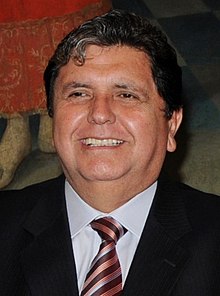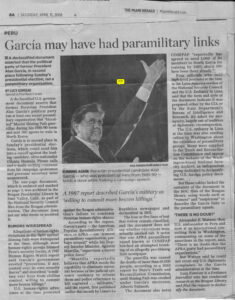
By Lucy Komisar
April 18, 2019
Former Peru President Alan García, who just shot and killed himself as police were moving to arrest him for massive corruption, ran a killer paramilitary organization during the late 80s. The U.S. knew about it but said and did nothing. I found and declassified a document in the Reagan Library revealing this and wrote about it for the Miami Herald in 2006.
I first wrote about the story for La República in Peru. The Herald referred to it in my 2006 article, but didn’t say I wrote it. García was running for president again, and the Herald held the story till after the election so it would not affect the vote. So voters would not know García had run a murderous paramilitary organization. Because the Herald was not an independent eye on events, it was a participant, it had a candidate. García won.
Here is the story that ran.
Saturday, Apr 15, 2006
PERU
García may have had paramilitary links
A declassified document asserted that the political party of former President Alan García, in second place following Sunday’s presidential election, ran a paramilitary organization.
BY LUCY KOMISAR
Special to The Miami Herald
A declassified U.S. government document asserts that former Peruvian President Alan García’s political party ran at least one secret paramilitary organization that ”bloodied” Maoist Shining Path guerrillas during his 1985-90 term and sent 300 agents to train in North Korea.
García is in second place in Sunday’s presidential elections, which could send him into a runoff against the leading candidate, ultra-nationalist Ollanta Humala. Phone calls and e-mails seeking comment from his campaign spokesman and personal secretary went unanswered.
The one-page document, which is undated and marked as page 3, was archived in the Reagan Presidential Library in Simi Valley, Calif., as part of the National Security Council files from the Reagan administration. The document does not say who wrote or received it.
RUMORS WIDESPREAD
Allegations of human-rights violations in the fight against Shining Path were widespread at the time, although most human-rights groups blamed Peru’s security forces. A 1987 Human Rights Watch report said García’s government exerted ”precarious, if any, control over its own security forces” and described “a military ever freer from civilian control, willing to commit more brazen killings.”
U.S. human-rights advocates at the time protested against the Reagan administration’s failure to condemn Peruvian human-rights abuses.
According to the report, García’s party — the American Popular Revolutionary Alliance, or APRA — ran ”a secret paramilitary organization, perhaps several” while his Deputy Interior Minister, Agustin Mantilla, “supervises a secret police force.”
”Mantilla reportedly believes that APRA needs the capability to eliminate terrorists because of the judicial system’s tendency to release them and police reluctance to kill captured . . . militants,” said the report, first published earlier this month by Lima’s La República newspaper and declassified in 2001. [The La Republica report was by me!]
The four or five lines of text that follow remain classified, and the document does not say whether executions were actually carried out. It notes that one APRA paramilitary squad known as COSEPAP botched an attempted bombing of an allegedly pro-Shining Path newspaper.
The guerrilla war caused the deaths of more than 69,000 people, according to a 2003 report by Peru’s Truth and Reconciliation Commission, until Shining Path was crushed under García’s successor, Alberto Fujimori.
The document also notes COSEPAP “reportedly has agreed to send 1,000 of its members to North Korea for training by 1989; about 300 have been there already.”
Four officials who held high-level positions at the time in the Latin America section of the National Security Council and the U.S. Embassy in Lima said that the form and style of the document indicate it was prepared either by the CIA or by the State Department’s Bureau of Intelligence and Research. All asked for anonymity, largely out of tradition of diplomatic circumspection.
The U.S. embassy in Lima at the time was also sending cables to Washington about the existence of paramilitary groups. Many were supplied to the Truth and Reconciliation Commission and appear on the website of the Washington-based National Security Archive, an independent group dedicated to declassifying U.S. foreign policy documents.
But those cables lacked the certainty of the document in the NSC files of the Reagan library, using words such as ”rumors” and ”suspicions” to describe the García links to the paramilitary squads.
`THERE IS NO DOUBT’
Alexander F. Watson, then U.S. ambassador to Peru and now at an international consulting firm in Washington, commenting on some of the assertions in the report, said, “There is no doubt that the APRA party had paramilitary organizations.”
But Watson said he could not recall any U.S. diplomatic complaints to the García administration at the time.
Lucy Komisar is a freelance journalist who has conducted research at the Reagan Library and filed the request to declassify the document.
See the Miami Herald and La República articles here. Click on clip below to make it larger.



